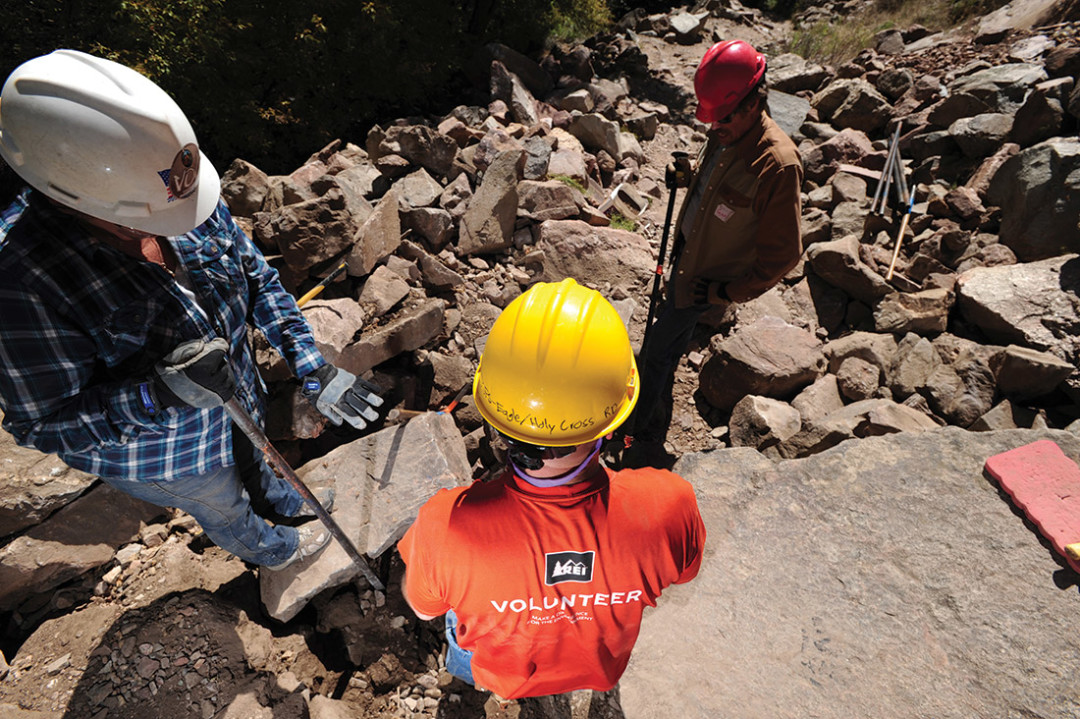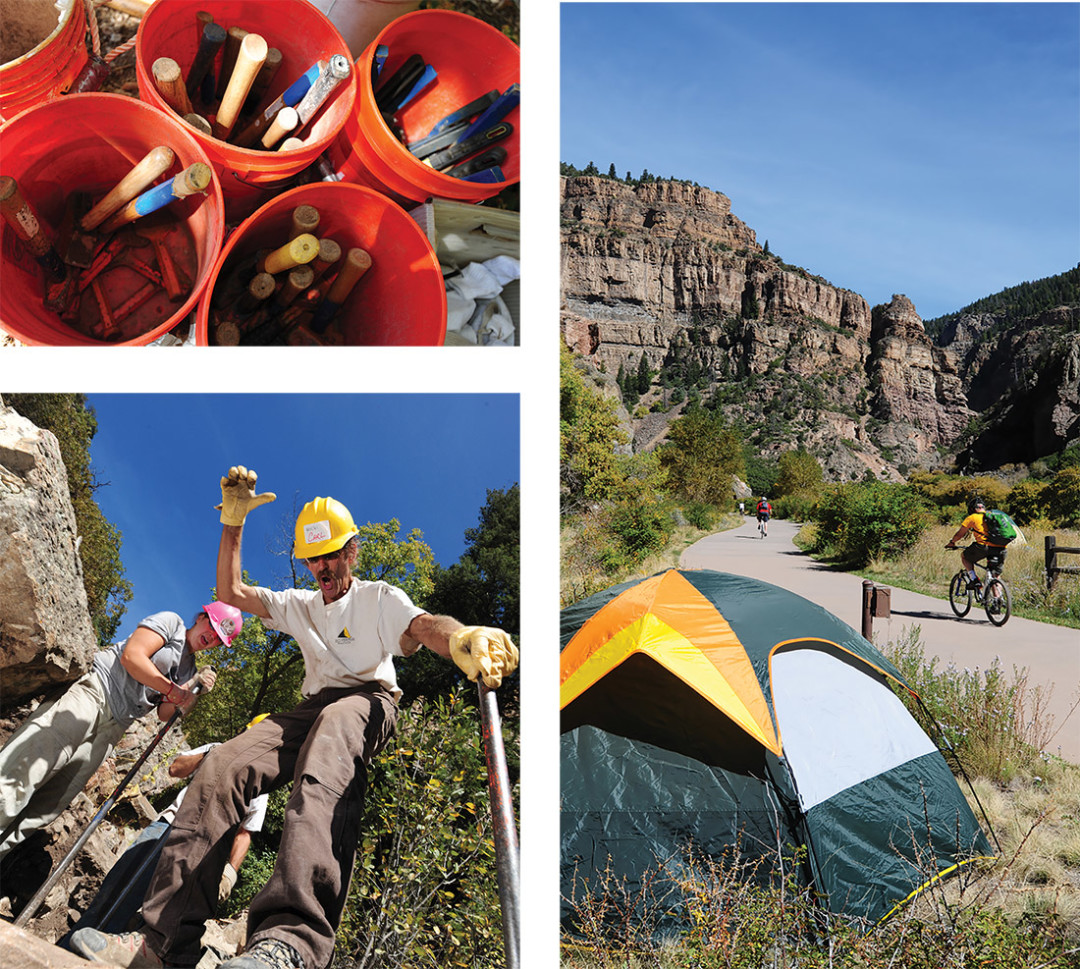How an Army of Local Volunteers Helps the Overstretched Forest Service Make Trail

Occasionally, RFOV volunteers camp at the worksite.
Image: Daniel Bayer
For most hikers, the switchbacks on the Ute Trail count as just another handful of steps on Aspen’s outdoor Stairmaster. But not for Amy Capron Barrow. She and some of those switchbacks have a history.
About a third of the way up the Ute lurks a hairpin turn that was once washed-out, narrow, and slick, the precise conditions for straining a calf or skinning a knee. Today, thanks to Capron Barrow and a team of volunteers, there are wide rock steps that provide sure footing and enough space for two-way traffic.
“We scouted for the right rocks and used an austin—it’s a tool that looks like a star radiating handles,” Capron Barrow says of the work. “Three to five people would carry one big rock together. You would think it would require a machine, but people power is impressive.”
Capron Barrow and her team built two sets of steps and a retaining wall on the Ute Trail that summer of 2006. All of the jobs were projects overseen by Roaring Fork Outdoor Volunteers (RFOV), a Basalt-based organization celebrating its twentieth anniversary this year. RFOV is one of several local nonprofits—others include the Forest Conservancy, Wilderness Workshop, and Aspen Center for Environmental Studies (ACES)—that have become vital to maintaining public lands.

Image: Daniel Bayer
“With a shrinking budget, we simply would not be able to survive without them,” says Karen Schroyer, the district ranger with the Aspen-Sopris Ranger District. “I hire roughly twenty seasonal employees each summer to cover 750,000 acres of forest in the Aspen-Sopris district. I supplement with our volunteer workforce. We use them five-to-one versus our paid seasonal employees.”
Access to able bodies, which can number in the hundreds—including as many as eighty RFOV team members on a single project—is essential to environmental nonprofits’ role in public-land management. But so too is competence. “The Forest Service signs a decision on a project, then RFOV will come and take it from there,” says Schroyer. “We just tell them where we need help; they have crew leaders on their end who can manage a project from implementation to completion.”
The hugely popular mountain bike network of Sky Mountain Park, the gravel trails that bear hundreds of visitors a day around Maroon Lake, and the Iowa Shaft Cutoff Trail, which brought a gentler, less steep route to the Hunter Creek–Smuggler area, are a small sampling of RFOV’s efforts. As David Hamilton, one of the organization’s founders and its current executive director, says, “We’ve worked on almost every trail in the valley.”
Hamilton’s teams are fairly easy to spot: they’re the folks happily doing manual labor on a public trail. When visitors to the wilderness encounter one of the Forest Conservancy’s 120 volunteers, however, they assume they’re talking to a paid ranger, since Forest Conser-vancy volunteers wear a uniform very similar to the Forest Service’s.
There’s good reason for that. The White River National Forest, which includes the Aspen-Sopris Ranger District, is the most visited National Forest in the United States. Yet its budget was cut by $2.7 million in 2013, and it has 131 full-time employees today, versus 178 ten years ago, handling the whole 2.2 million acres of the White River National Forest. Schroyer points out that when visitors come to the wilderness, they expect to see a ranger.
“It gives visitors a sense of security and the understanding that the forest is being cared for,” she says. “We’re hoping education and outreach instills a sense of stewardship. The presence of a ranger makes all the difference. Between the Forest Conservancy and ACES, we have a volunteer at the Maroon Bells every single weekend and for much of the week.”
For Donna Chase, the uniform was part of the Forest Conservancy’s initial appeal when she signed up five years ago. A dedicated hiker, Chase says she would notice things when she was out—“people throwing trash, dogs off leash, people going off trail”—and wanted to be able to do something about it.
But being an authority figure soon gave way to something more meaningful. “People ask me questions,” Chase says. “When I’m out on a trail, someone may approach me and say, ‘I just saw this thing that looked like a chicken.’ I’ll tell them that it was a grouse. Because I wear a uniform, they assume I know what I’m talking about. That’s made me want to learn more about trees, birds, and habitat. It’s a major part of my life now.”
Chase has gone on to become a master naturalist, one of three Forest Conservancy volunteer classifications, along with ranger and ambassador. She led a tundra class at the top of Independence Pass last year, and she has a group of “learning buddies” with whom she gets together to talk about what each has picked up in the field. “It reinforces the learning,” she says. “It makes us better resources.”
RFOV’s Hamilton emphasizes the social aspect of outdoor volunteerism, too. Whether restoring a wetland, removing invasive species, or building a trail start to finish, “we want volunteers to have a great time,” he says. “We start at 8:30 with coffee, pastries, and juice. Crews are six to eight people; there may be six to seven crews out on a trail project. When they’re done, they walk back through the work of others—sometimes on a trail that wasn’t there before. We feed them dinner as close to where they worked as possible. That’s when our glow—the organization’s, the project’s, the camaraderie’s—sets in.”













































